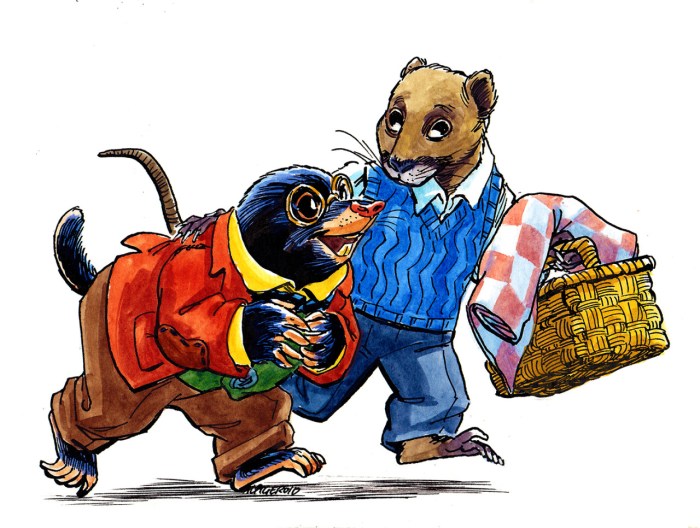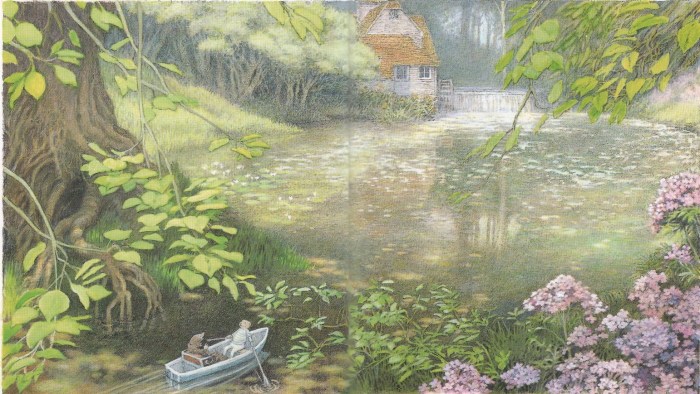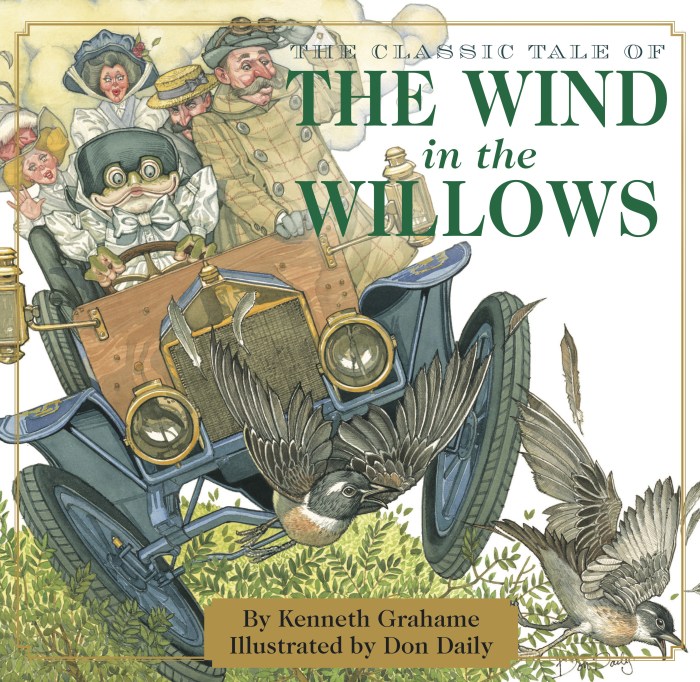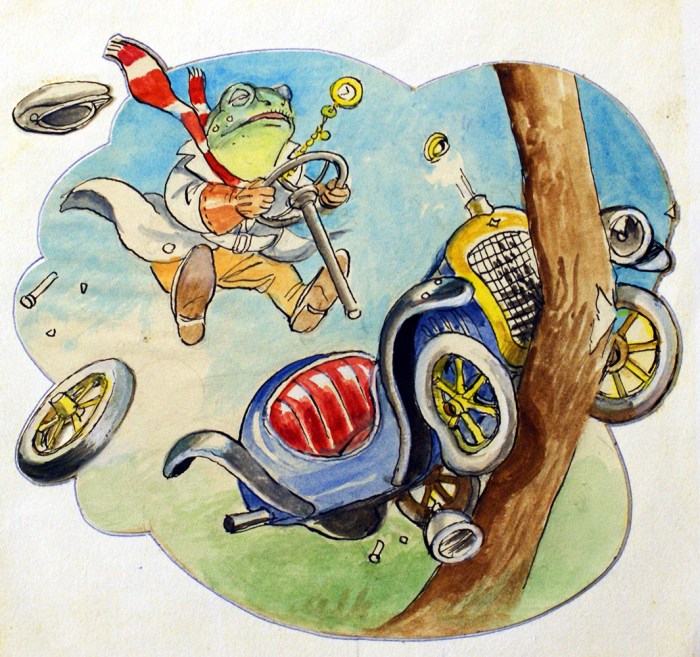Wind in the willows squire – Embark on a literary journey with “Wind in the Willows,” where we delve into the enigmatic character of the Squire. This beloved tale unravels a world of anthropomorphic animals, captivating readers with its timeless themes and enchanting prose.
The Squire, a prominent figure in this whimsical narrative, embodies a complex blend of eccentricities and profound wisdom. His interactions with Mole, Ratty, and Badger shape the story’s trajectory, while the ever-present wind whispers secrets and carries the characters along its currents.
Characterization of the Squire

The Squire is a wealthy and benevolent landowner who resides in Toad Hall. He is known for his kind and generous nature, and he is always willing to help those in need. He is also a bit of a dreamer and a poet, and he loves to spend his time writing poetry and painting.
The Squire is a close friend of Mole, Ratty, and Badger. He is always there to help them out of trouble, and he is always willing to lend a helping hand. He is also a bit of a father figure to Mole, and he is always there to give him advice and support.
Relationship with Other Characters
The Squire is a well-respected figure in the community, and he is loved by all who know him. He is a kind and generous man, and he is always willing to help those in need. He is also a bit of a dreamer and a poet, and he loves to spend his time writing poetry and painting.
The adventures of the Wind in the Willows squire are sure to captivate young readers. To enhance their vocabulary while enjoying the book, parents and educators can refer to vocab book level f answers . This comprehensive resource provides definitions and examples for key terms encountered in the novel, ensuring that young readers fully grasp the nuances of the story.
The Squire is a close friend of Mole, Ratty, and Badger. He is always there to help them out of trouble, and he is always willing to lend a helping hand. He is also a bit of a father figure to Mole, and he is always there to give him advice and support.
Role in the Narrative
The Squire plays an important role in the narrative. He is a mentor and a guide to Mole, and he helps him to learn about the world and to find his place in it. He is also a source of support and stability for Ratty and Badger, and he helps them to overcome their challenges.
The Squire is a complex and well-developed character. He is a kind and generous man, but he is also a bit of a dreamer and a poet. He is a close friend to Mole, Ratty, and Badger, and he plays an important role in the narrative.
The Significance of the Wind in the Willows
The wind in The Wind in the Willowsis more than just a force of nature; it is a symbol of change, adventure, and the unknown. It represents the longing for something more than the ordinary and the desire to break free from the constraints of everyday life.
The Wind’s Influence on the Characters
The wind has a profound influence on the characters in the story. It is the wind that first calls to Ratty and Mole, enticing them to leave their comfortable homes and embark on an adventure. It is also the wind that brings them to Toad Hall, where they meet Toad and embark on a series of misadventures.
The wind represents the spirit of adventure and the desire to explore the unknown. It is a force that pushes the characters outside of their comfort zones and encourages them to take risks. It is also a force that can be destructive, as seen when Toad crashes his motorcar into a willow tree.
The Wind’s Reflection of the Story’s Themes
The wind also reflects the story’s themes of friendship, loyalty, and the importance of home. The wind is a constant presence throughout the story, and it is a reminder that even when the characters are far from home, they are still connected to each other and to the place they call home.
The wind is also a symbol of hope. It is a reminder that even in the darkest of times, there is always hope for a better future. The wind is a force that can change the course of events, and it is a reminder that anything is possible.
The Role of Nature in the Story
The setting of The Wind in the Willowsis a pastoral, idyllic countryside, where the River Thames and its surrounding meadows, woods, and fields provide a backdrop for the adventures of the animal characters. Nature is a central and essential element in the story, shaping the characters’ experiences, perspectives, and relationships.
The characters’ interactions with the natural world are multifaceted and complex. They find solace and inspiration in nature, but they also face challenges and dangers. The river, for example, is a source of both beauty and peril, providing a pathway for adventure but also posing threats of drowning and storms.
Nature and Character Development
Nature plays a significant role in the development of the characters. The idyllic setting of the countryside provides a sense of peace and tranquility, allowing the characters to reflect on their lives and relationships. The challenges and dangers of the natural world also test the characters’ courage and resilience, helping them to grow and mature.
The Themes of the Story: Wind In The Willows Squire

The Wind in the Willowsexplores several important themes, including the importance of friendship, the value of nature, and the search for identity.
Friendship
Friendship is a central theme in the story. The four main characters—Mole, Rat, Toad, and Badger—are all close friends who support each other through thick and thin. They share adventures, help each other out of trouble, and always have each other’s backs.
Nature
Nature is another important theme in the story. The characters live in a beautiful natural setting, and they spend much of their time exploring the river, the woods, and the countryside. Nature is a source of joy and peace for the characters, and it helps them to connect with their true selves.
Identity
The characters in The Wind in the Willowsare all on a journey to find their true identities. Mole is shy and insecure, but he learns to be more confident and assertive. Rat is practical and organized, but he learns to appreciate the beauty of nature.
Toad is reckless and impulsive, but he learns to be more responsible. Badger is wise and experienced, but he learns to let go of his past.
The Significance of These Themes
The themes of friendship, nature, and identity are all important to the overall message of The Wind in the Willows. The story shows us that friendship is essential for a happy and fulfilling life. It also shows us that nature is a valuable resource that should be cherished.
And finally, it shows us that everyone is on a journey to find their true identity.
The Historical Context of the Story

The Wind in the Willows was written by Kenneth Grahame in 1908, during a period of significant social and cultural change in England. The Victorian era was coming to an end, and the Edwardian era was beginning. This was a time of great prosperity and technological advancement, but also of social unrest and political upheaval.
The story reflects the values and beliefs of the time period in several ways. First, it celebrates the importance of nature and the countryside. This was a common theme in Edwardian literature, as people sought to escape the hustle and bustle of city life.
Second, the story emphasizes the importance of friendship and community. This was also a common theme in Edwardian literature, as people sought to find meaning and belonging in a rapidly changing world.
The Author’s Personal Experiences, Wind in the willows squire
The story was also influenced by Grahame’s personal experiences. Grahame was born in Scotland in 1859, and he spent his childhood in the countryside. He loved nature, and he often wrote about his experiences in his stories. The Wind in the Willows is full of descriptions of the natural world, and it is clear that Grahame had a deep love for the countryside.
Grahame also had a difficult childhood. His father was an alcoholic, and his mother died when he was young. Grahame was raised by his aunt and uncle, and he often felt like an outsider. This experience may have influenced his writing, as he often wrote about characters who are searching for a place to belong.
The Literary Devices Used in the Story

Kenneth Grahame’s “The Wind in the Willows” employs a range of literary devices to enhance its storytelling, deepen its themes, and create a vivid and immersive experience for readers. These devices include symbolism, foreshadowing, and imagery, each contributing to the story’s meaning and impact.
Symbolism
Symbolism is used extensively in the story to represent abstract ideas and emotions through concrete objects or characters. For instance, the river symbolizes the journey of life, with its ever-flowing current representing the passage of time and the challenges and opportunities it brings.
Similarly, the animals represent different human qualities, such as Toad’s impulsiveness, Ratty’s practicality, and Badger’s wisdom.
Foreshadowing
Foreshadowing is another literary device employed by Grahame to create suspense and anticipation. Throughout the story, subtle hints and clues are scattered that foreshadow future events. For example, the description of the “Wild Wood” as a place of mystery and danger foreshadows the challenges the characters will face within it.
Similarly, the recurring image of the “open road” foreshadows the adventures and self-discovery that lie ahead for the characters.
Imagery
Grahame’s use of vivid and evocative imagery creates a rich sensory experience for readers. Through detailed descriptions of the natural world, the characters’ emotions, and the atmosphere of the story, he immerses readers in the setting and allows them to experience the events alongside the characters.
For instance, the description of the “Wind in the Willows” as “a mighty orchestra” creates a vivid impression of the power and beauty of nature.
The combination of these literary devices enhances the storytelling in “The Wind in the Willows,” making it a timeless classic that continues to resonate with readers of all ages.
General Inquiries
Who is the Squire in “Wind in the Willows”?
The Squire is a wealthy and eccentric landowner who lives in a grand house in the countryside. He is a kind and generous host, but he is also known for his unpredictable behavior and his love of practical jokes.
What is the significance of the wind in “Wind in the Willows”?
The wind is a symbol of change and adventure in “Wind in the Willows.” It carries the characters along on their journey and helps them to discover new places and experiences.
What are the major themes of “Wind in the Willows”?
The major themes of “Wind in the Willows” include friendship, nature, and the importance of imagination.